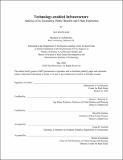| dc.contributor.advisor | James L. Wescoat Jr. and David M. Geltner. | en_US |
| dc.contributor.author | Kim, Sea Hoon. | en_US |
| dc.contributor.other | Massachusetts Institute of Technology. Department of Architecture. | en_US |
| dc.contributor.other | Massachusetts Institute of Technology. Center for Real Estate. Program in Real Estate Development. | en_US |
| dc.date.accessioned | 2020-09-15T22:03:25Z | |
| dc.date.available | 2020-09-15T22:03:25Z | |
| dc.date.copyright | 2020 | en_US |
| dc.date.issued | 2020 | en_US |
| dc.identifier.uri | https://hdl.handle.net/1721.1/127554 | |
| dc.description | Thesis: S.M., Massachusetts Institute of Technology, Department of Architecture, May, 2020 | en_US |
| dc.description | Thesis: S.M. in Real Estate Development, Massachusetts Institute of Technology, Program in Real Estate Development in conjunction with the Center for Real Estate, May, 2020 | en_US |
| dc.description | Cataloged from the official PDF of thesis. | en_US |
| dc.description | Includes bibliographical references (pages 94-101). | en_US |
| dc.description.abstract | This research proposes a conceptual and analytical framework for understanding technology-enabled infrastructure. Three strategies -creating new assets, layering uses and increasing utilization- are identified, which constitute technology-enabled infrastructure. The strategies are studied and analyzed through interviews and a case-based method. The cases discussed are Link NYC and BigBelly, both in contexts in New York City. These cases are evaluated using four lenses that are economic, social, environmental and user/urban experience. Variables are selected based on their pertinence to technology-enabled infrastructure, and they form the basis for understanding the intrinsic value of each case. These variables are public benefit, competition, physical, digital and social. Early findings indicate that creating and retaining ability to innovate throughout the lifespan of an infrastructure is a key element to technology-enabled infrastructure. To ensure a lasting success, the three strategies of infrastructure are recommended to be seen as a part of larger strategy, not as single or parallel strategies. | en_US |
| dc.description.statementofresponsibility | by Sea Hoon Kim. | en_US |
| dc.format.extent | 101 pages | en_US |
| dc.language.iso | eng | en_US |
| dc.publisher | Massachusetts Institute of Technology | en_US |
| dc.rights | MIT theses may be protected by copyright. Please reuse MIT thesis content according to the MIT Libraries Permissions Policy, which is available through the URL provided. | en_US |
| dc.rights.uri | http://dspace.mit.edu/handle/1721.1/7582 | en_US |
| dc.subject | Architecture. | en_US |
| dc.subject | Center for Real Estate. Program in Real Estate Development. | en_US |
| dc.title | Technology-enabled Infrastructure : analysis of its economics, public benefits and urban experience | en_US |
| dc.type | Thesis | en_US |
| dc.description.degree | S.M. | en_US |
| dc.description.degree | S.M. in Real Estate Development | en_US |
| dc.contributor.department | Massachusetts Institute of Technology. Department of Architecture | en_US |
| dc.contributor.department | Massachusetts Institute of Technology. Center for Real Estate. Program in Real Estate Development | en_US |
| dc.contributor.department | Massachusetts Institute of Technology. Center for Real Estate | |
| dc.identifier.oclc | 1193319421 | en_US |
| dc.description.collection | S.M. Massachusetts Institute of Technology, Department of Architecture | en_US |
| dc.description.collection | S.M.inRealEstateDevelopment Massachusetts Institute of Technology, Program in Real Estate Development in conjunction with the Center for Real Estate | en_US |
| dspace.imported | 2020-09-15T22:03:25Z | en_US |
| mit.thesis.degree | Master | en_US |
| mit.thesis.department | Arch | en_US |
| mit.thesis.department | RED | en_US |
